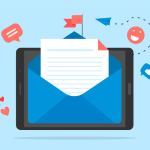Introduction.
Email marketing remains one of the most effective ways to reach and engage customers. With billions of active email users worldwide, it’s clear that email is still very much alive—and kicking.
If you’re looking to give your sales a serious boost, refining your email marketing strategy is an absolute must.
You might wonder, why should I invest my time and energy into email marketing. It’s simple: email marketing gives you the power to connect with people right where they’re most active.
People check their emails multiple times a day, and an engaging, well-timed message can transform a curious prospect into a loyal customer.
According to HubSpot, email marketing has an impressive average return on investment (ROI) of $36 for every $1 spent. That statistic alone is enough to show the potential email marketing holds.
But to succeed, you need more than a “spray and pray” approach. It’s all about crafting the right messages and delivering them at the right time to the right people. So let’s explore how to increase your sales through email marketing.
The Basics of Email Marketing Success
Before diving into tips and strategies, let’s cover the essential components of a solid email marketing campaign:
- Audience Segmentation: Not every customer is the same, so segmenting your audience based on their preferences, behaviour, or demographics is crucial. Sending relevant content tailored to different segments increases the likelihood of engagement.
- Compelling Content: Crafting emails that your audience wants to read is an art. Your subject lines need to grab attention, and the body of the email should be engaging, easy to read, and offer clear value.
- Call to Action (CTA): A CTA is the backbone of driving conversions. It should be clear, concise, and compelling enough to make your reader take the next step, whether it’s making a purchase, signing up for a webinar, or downloading a guide.
- Automation and Timing: Consistency matters, but so does timing. Using automation tools can help you send messages at optimal times, improving open and click-through rates.
Pros and Cons of Email Marketing
While email marketing can be a game-changer for your business, it comes with its advantages and challenges. Understanding both can help you use it more effectively.
Pros
- High ROI: As mentioned earlier, email marketing delivers an incredible return on investment, making it one of the most cost-effective marketing channels.
- Direct Access to Your Audience: Unlike social media, where algorithms dictate what your audience sees, email lets you connect directly with your subscribers.
- Personalization and Customization: You can tailor your messages for specific segments, making your marketing feel more personal and engaging.
- Easy to Track and Analyze: Most email marketing platforms come with built-in analytics to track open rates, click-through rates, and conversions, allowing you to tweak and improve your campaigns.
- Automation: Automation tools help you create workflows to nurture leads and engage with customers without the need for constant hands-on management.
Cons
- Spam Filters: If your emails aren’t carefully crafted, they can end up in spam folders and never be seen.
- List Maintenance: Keeping your email list clean and updated takes time. People unsubscribe, emails bounce, and inactive subscribers can drag your performance down.
- Design and Content Challenges: It can be tricky to create email content that looks good across all devices and doesn’t get flagged as spam.
- Information Overload: People’s inboxes are flooded daily, so standing out can be tough. Without engaging content, your emails may be ignored.
How Do I Increase Sales Through Email Marketing?
Here’s what you can do to increase sales through email marketing:
1. Personalize Your Emails.
Customers love it when emails feel tailored to them. Use their names and craft messages that relate to their interests or past interactions with your brand.
According to Campaign Monitor, emails with personalized subject lines are 26% more likely to be opened. Even simple personal touches can make a huge difference.
2. Create Value-Driven Content.
Don’t just push products; share content that provides value. This could include how-to guides, industry insights, or tips related to your offerings. By offering value, you’ll build trust and keep your audience engaged.
3. Make Your CTAs Irresistible.
Focus on clear and direct CTAs. Use action-oriented language like “Get Started,” “Learn More,” or “Shop Now.” If you’re running a special deal, make sure it’s obvious.
4. Send Cart Abandonment Emails.
If you run an e-commerce store, sending a friendly reminder when someone leaves an item in their cart can recapture lost sales.
Cart abandonment emails have a high open rate and can prompt customers to complete their purchases.
5. Leverage Automation and Segmentation.
Automation allows you to send timely, relevant emails without having to manage every step manually.
Create automated campaigns for onboarding new subscribers, nurturing leads, or sending birthday wishes. Segment your list to make your campaigns as relevant as possible.
6. A/B Test Your Campaigns.
Don’t just stick to one formula. Test different subject lines, CTAs, and content formats to see what resonates best with your audience. The data you collect will help you fine-tune your approach and improve results over time.
FAQs
Q: How often should I send marketing emails?
A: There’s no one-size-fits-all answer, but a good starting point is once a week or bi-weekly. Monitor your open rates and feedback to adjust your frequency.
Q: What is the best time to send marketing emails?
A: It depends on your audience. However, research often points to Tuesday and Thursday mornings as optimal times. A/B testing will help you find the perfect time for your subscribers.
Q: How do I avoid my emails going to spam?
A: Use a verified email address, avoid spammy words (like “free” or “urgent”), and keep your list clean. It also helps to ask subscribers to add your email to their address book.
Q: What should I include in a welcome email?
A: A warm welcome, a brief introduction to your brand, and a clear CTA. Consider offering a discount or free resource to new subscribers.
Q: How do I measure the success of my email marketing campaign?
A: Track metrics like open rates, click-through rates, conversion rates, and unsubscribe rates. These numbers will give you insights into what’s working and what needs improvement.
Conclusion
Email marketing, when done right, can be a powerful tool to boost sales and nurture long-term customer relationships.
It’s about striking the right balance between offering value and promoting your products. Test, tweak, and learn from each campaign, and you’ll find a strategy that works for your audience.
So, what’s the next email you’re planning to send, and how can you make it more impactful? Let me know your thoughts.





GIPHY App Key not set. Please check settings